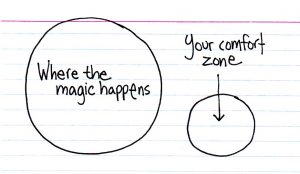- Teaching What You Thought You Knew (Part 4): El beísbol
- Teaching What You Thought You Knew (Part 3): Colombian Music, or how I learned to appreciate Hip Hop after 40
- Teaching What You Thought You Knew (Part 2): Colombian Film
- Teaching What You Thought You Knew (Part 1): Colombia
A thousand years ago, I studied at the Universidad de los Andes in Bogotá, Colombia. I went during college and then back again for a year after I graduated. Those were important years in my life and in my growth as a Spanish speaker. A great deal of what I experienced there informed some of the things I taught and continue to teach in my classes.
When I was preparing to teach HISP 205 last winter, I had a stunning realization: the last time I had set foot in Latin America, in particular Colombia, was before my students were born.
As a language teacher, my job (I believe) is to make language relevant by relating it to the countries where it is spoken and the people who speak it. Textbooks try to do that and don’t succeed. Why? because their stuff is generic. And outdated.
But then again… so was I, or rather, so was my knowledge about a place I thought I knew.
Add to this the added intrigue (and the added friction) of having a colleague at work, a one-year adjunct native Spanish speaker (although he would be the first to object about the term “native,” implying that this was some sort of subtle jingoistic term used by my people to talk about his…but that is a whole ‘nuther blog post right there…sigh), anyway, this colleague made it quite clear that people like me (English speakers for whom Spanish is their second language) should NOT be teaching the language for EXACTLY the reason that we as English speakers are “distant” from real, authentic language usage.
So here I was… teaching something I thought I knew, but now wondered if maybe I didn’t, with 3 weeks to go before the semester began.
What to do? Where to begin? Where do you start (and how do you teach?) when you realize that everything you thought you knew is no longer relevant?
In a leap of faith, or perhaps a foolish move, I didn’t know (yet), I decided to model for my students, through my own trial and error, the type of learning path that I wanted them to pursue for themselves in HISP 205. To essentially learn alongside them, and with them, for a semester.
I also wanted to exemplify and be a part of active learning…I wanted to be able make sure we got the opportunity to talk to people, real people, vs just being passive observers.
I knew that I needed to dismantle and challenge some of the stereotypes that permeate the US media’s coverage of Colombia…something the Colombians themselves acknowledge as the “la mala fama” as well as highlight all of the current events that the US media also ignores. As of January, Obama was scheduled to go to Colombia in March of 2011. The timing of his visit and my new found ignorance was perfect. (He ended up not going after all, oh well.)
So, what will follow here (in what is bound to be a series of posts) is what I did and how I did it and how it turned out.
So, why should you care?
-I hope this is helpful to other language teachers (maybe even cathartic) to see someone acknowledge her own shortcomings and then try to fix’em,
-I hope the info provided about what we covered and who we talked to will help other teachers think about ways to actively engage with people, vs settling for students (and teachers) being passive observers.
Stay tuned.


Barbara,
Your post really hit home for me.My degrees are in medieval French languages and literatures, which I taught for a long time in an older paradigm. But my French students in Drake’s DULAP program posed a very different problem when I developed a course called “French National Identity in a Transcultural Age”. I realized they needed to know how to find out about what it is like to be in France. Students in this course were fairly competent in the language, but they couldn’t read a news article or understand a TV news show.My specialty as a medievalist was only marginally useful. What was missing for them (and also for me) was the cultural context. Like you and your aging language experience, I did well in the milieu I had studied, but reading the news posed a challenge to me, too. Together we devised a new way to think about learning the language-in-context, and to mine the Internet for resources, and to connect with native speakers of French in France to help us sort out the mysteries. It was the beginning of a new approach to shared learning for me.
I can’t wait for the next installment in your story. I hope you will talk about the wonderful things you have done to connect your students with the language they are studying, as well. You’re inspiring.
Jan Marston
[…] also read some interesting blog postings, especially those by Barbara Sawhill in her Language Lab Unleashed! She is a fellow Spanish teacher, so her posts are extremely relevant for me! I found I could spend […]